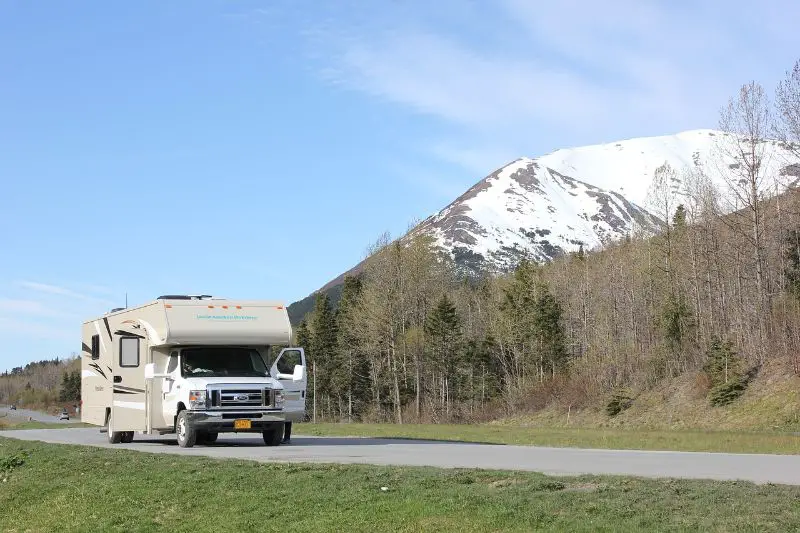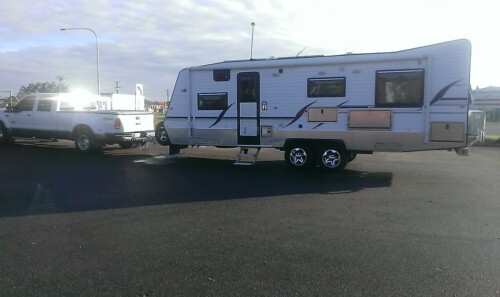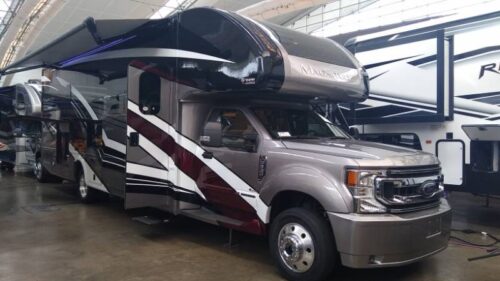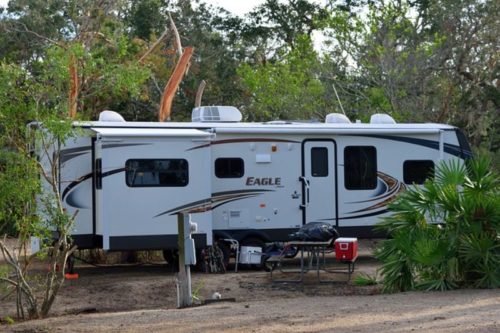Many people have never driven anything larger than a zero-turn lawnmower before driving their first RV.
And your first at the helm of a 15-ton Class A motorhome or towing a 5-ton 5th wheel can be, shall we say, unnerving. White knuckles, beads of sweat, whispered prayers, existential bargaining.
But anyone can learn to drive an RV safely, whether it’s a truck camper, travel trailer, or motorhome!
But properly piloting an RV takes prowess. You shouldn’t assume your years of playing Forza 4 will automatically transform you into the next Mario Andretti.
So before you press that gas pedal (or sign the finance contract), here’s what all RV drivers – and buyers! – should know about RV weight, length, width, and height.

Table of Contents
What Does an RV Weigh?
How much does an RV weigh?
Well now, that would depend.
- A uber-lightweight teardrop sleeper may weigh as little as 400 pounds.
- An empty 28-ft travel trailer might weigh 6,500 lbs.
- A fully loaded 45-ft Class A diesel coach could weigh up to 46,000 pounds!
But why should you care what an RV weighs? Isn’t that the engine’s concern?
Well, if your route passes over a bridge with a posted weight limit of 5 tons, then you and your Class A behemoth might start to care!
RV weight and weight distribution can affect the following:
- Road safety and routing
- Permits and licensing
- Towing capacity and safety
Weight Restrictions for Road Safety
According to the U.S. Secretary of Transportation (May 2015):
“Federal law controls maximum gross vehicle weights and axle loads on the Interstate System. Federal limits are 80,000 pounds gross vehicle weight, 20,000 pounds on a single axle, and 34,000 pounds on a tandem axle group.”
States have their own restrictions, although most are consistent with federal standards. You can read the full list of state weight restrictions here.
While RVs rarely weigh too much for a solid road surface, bridges are another matter.
Many rural bridges have posted maximum weight signs, like this:

These signs may restrict:
- Total weight of individual vehicle[s]
- Total combined vehicle[s] weight
- Total weight broken down by number of axles or number of units.
Something you should know is that these weight restrictions may change over time. Bridges must be inspected on a periodic basis, and if the inspector deems the bridge degraded or deteriorated, then the allowable weight will decrease.
In one Delaware town, the posted weight limit dropped practically overnight from 15 to 5 tons!
Let’s consider some common bridge maximum weight restrictions and compare what size of RV can be accommodated.
Keep in mind that tow vehicles generally range between 4,000 lbs (2-row SUV) to 7,000 lbs (three-quarter-ton truck).
- 5 tons (10,000 lbs) – You might get away with a compact travel trailer or slide-in truck camper. Or a Class B or compact Class C motorhome.
- 8 tons (16,000 lbs) – Most combinations with travel trailers and the majority of 5th wheels will squeak by. Also most Class C motorhomes and a few compact Class A’s.
- 10 tons (20,000 lbs) – This is a comfortable weight limit for most RVs, whether towable or motorhome. However, if your motorhome is towing a second vehicle, you’re probably too heavy. At this weight limit and more, bridges often have limits broken down by number of axles or vehicle combination type. Read and understand the posted weight limit before pushing full steam ahead!
- 13 tons (26,000 lbs) – Watch out! You’ve hit the magic GCVWR limit in many states for a regular driver’s license! If you’re driving a Class A in excess of a 26,000 pounds or towing trailer with a total combined weight of more than 26,000 pounds, you’ll probably need a non-commercial Class A or Class B license.
Let’s talk more about licensing below.
Weight Restrictions – Permits and Licensing
As we explained in RV Driving License Requirements:
Generally, no, you don’t need a special driver’s license to drive an RV.
According to current laws across all 50 states, if your motorhome weighs less than 26,000 pounds or your trailer weighs less than 10,000 lbs, you do not need a special license to operate.
If you exceed the limit, then in most states:
- You need a Class B license for a single-vehicle over 26,000 pounds
- Or a Class A license (non-commercial CDL) to drive a combination of vehicles that weigh over 26,000 pounds
Again, you usually are not required to carry a commercial license to drive an RV of almost any size or weight. But this varies by state, so check with your local DMV.
(So if you want that gigundous Thor Tuscany Class A RV with a GVWR of 46,000 pounds, you’ll probably need a special driver’s license.)
Weight Restrictions – Towing Capacity and Safety
(Apologies in advance – this section is mostly alphabet soup.)
With all this talk about weight, you’d think every RV owner would know precisely how much their RV weighed.
Unfortunately, many don’t! Many have no clue what their RV or tow vehicle weighs when fully loaded.
If you take away nothing else from this section, remember this:
Weigh your empty RV, fully loaded RV, and fully loaded tow vehicle, on a certified scale.
But let’s get more specific. There’s no such thing as “RV weight.” That’s not a recognized term. Instead, manufacturers use standard weight measurements and capacities. You should too.
Here are some acronyms and definitions you should know:
Weights You Should Know! – Towable RVs
UVW
Unloaded Vehicle Weight (UVW), also known as empty weight or factory weight, is the actual weight of an empty towable RV as configured by the factory and as measured by a scale (or within 1%).
GTW
Gross Trailer Weight (GTW) is the actual weight of a fully loaded trailer, including all cargo, water and propane and other fluids, and optional equipment, as measured by a scale. GTW is determined by weighing the entire camper without the tow vehicle attached.
GVWR
Gross Vehicle Weight Rating (GVWR) is the maximum number that the weight of the loaded RV should never exceed. In other words, this is the most that the RV should ever weigh. This capacity is set by the manufacturer and cannot be changed.
GAWR
Gross Axle Weight Rating (GAWR) is the maximum number that the GAW should never exceed. On multi-axle trailers, each axle has its own GAWR, and the sum of the axle has its own GAWR. Sometimes, the total GAWR is equal to the sum of each GAWR, but it may be less depending on axle equalization. The GAWR is limited by the weakest link in the suspension, whether that be hub, axle, spindle, tire or spring. This number is set by the manufacturer and cannot be changed.
Tongue Weight/King Pin Weight
The Maximum Tongue Weight and Maximum King Pin Weight is the most weight that should be pressing down vertically on the tow vehicle hitch at the trailer coupler or 5th wheel kingpin.
CCC
Cargo Carrying Capacity (CCC) is the maximum weight of allowable cargo after the weight of passengers in transit and operating fluids, like freshwater, have been subtracted.
CCC can be rather confusing to calculate. For more information on CCC, please see Understanding RV Weights.
Weights You Should Know – Tow Vehicle and Motorhomes
GVW
Gross Vehicle Weight (GVW) is the actual weight of the fully loaded vehicle, including all cargo, fluids, passengers, and optional equipment, as measured by a scale. GVW is determined by weighing the entire tow vehicle, without the trailer attached.
GVWR
Gross Vehicle Weight Rating (GVWR) is the maximum number that the GVW should never exceed. In other words, this is the most that the tow vehicle should weigh. This capacity is set by the manufacturer and cannot be changed.
RGAW
Rear Gross Axle Weight (RGAW) is the actual weight placed on the rear axle. Assuming a well-balanced vehicle, the RGAW is evenly distributed to all tires on that axle. RGAW is determined by weighing all wheels on the rear axle, without the trailer or toad vehicle attached.
RGAWR
Rear Gross Axle Weight Rating (RGAWR) is the maximum number that the RGAW should never exceed. In other words, this is the most weight that the tow vehicle’s rear axle should carry.
GCWR
Gross Combination Weight Rating (GCWR) is the maximum number that the tow vehicle GVW plus the trailer GVW should never exceed. In other words, this is the most that the entire RV should weigh. This includes the tow vehicle, trailer, anything towed behind the trailer, and everything inside and on top.
Maximum Towing Capacity
Towing capacity is the heaviest trailer or toad that the vehicle should tow, as determined by the manufacturer. This is usually called the maximum trailer weight. And as you can see in our Towing Calculator, the stated value is rarely accurate for real-world towing!
Hitch Rating
Hitch Rating is the most weight that a hitch can support vertically or pulling horizontally. This rating may be specified by the vehicle manufacturer and the hitch manufacturer—if they are different, use the smaller number. For ball mount hitches, this rating refers to the weight pressing down vertically. For fifth wheel hitches, this rating refers to the pin weight.
Here is a table of common hitch weight classes:
| Where Used | Receiver Size | GTW Max | TW Max | WDH Max | WDH TW Max | |
|---|---|---|---|---|---|---|
| Class 1 | Cars | 1-1/4" | 2,000 lbs | 200 lbs | X | X |
| Class 2 | Minivans, CUVs, SUVs | 1-1/4" | 3,500 lbs | 350 lbs | X | X |
| Class 3 | SUVs, pickup trucks, vans | 2" | 8,000 lbs | 800 lbs | 12,000 | 1,200 |
| Class 4 | Pickup trucks | 2" | 10,000 lbs | 1,000 lbs | 12,000 | 1,200 |
| Class 5 (a) | "HD" pickup trucks | 2" | 16,000 lbs | 2,550 lbs | 17,000 | Same |
| Class 5 (b) | "HD" pickup trucks | 2-1/2" | 20,000 lbs | 2,700 lbs | 20,000 | Same |
For more information on this topic, please read How to Choose a Tow Vehicle.
Weight Distribution – the Unseen Killer
And finally, one last note on weight – specifically, weight distribution.
It is commonly assumed that RVs are balanced evenly side to side, with each set of tires carrying 50% of the weight. Or it is assumed that the front and rear axles of a motorhome both carry 50% of the total weight.
That is rarely true. Most RVs come imbalanced from the factory. Full water tanks can further exacerbate the problem.
When you load an RV close to its GVWR, weight distribution becomes critically important.
It is all too easy to overload a tire when side-to-side weight distribution is 54/46%.
Yes, RV tires are required to have a 10% safety margin – but that’s at maximum pressure. If you forgot to air up your tires this morning, it’s quite likely you’ve overloaded at least one of your tires, even if you are under the allowable GVWR.
Back in the ‘90s, this was a horrendous problem with many Class A motorhomes. Tire blow-outs were all too common. And the results were sometimes deadly.
So again – weigh your RV! Weigh everything about it: front-to-back weight distribution, side-to-side weight distribution, weight of full tank water tanks, weight of your cargo, etc.
Your life could depend on it.

When Size Matters: RV Length
Total Length
There is more variety in RV length than any other dimension.
- The shortest “RVs,” usually teardrop trailers, may be as short as 10 feet!
- The longest RVs may be as large as 45 feet! (That’s three Asian elephants standing single-file).
RV length is measured from tip to tail!
- For a motorhome, length is measured from the front bumper to the rear bumper.
- For a travel trailer, length is measured from the front of the coupler to the rear bumper or rear wall, whichever is furthest.
- For a 5th wheel, length is measured from the front nose of the overhang to the rear bumper or rear wall, whichever is furthest.
Ladders, spare tires, lights, and other components are not included in these measurements so long as they are less than six inches in depth.
All states have restrictions on the total length of motorhome and towable RVs and trailers. You can read those rules (courtesy of RVIA) here.
Also, most campgrounds have length restrictions. This is especially true for National Parks, state parks, and primitive campgrounds. Read our article here about the best RV length for National Parks.
Body Length
Please note that in many instances the total length doesn’t equal the body length!
Most travel trailers, for instance, will have a body length about four feet less than the total length because the trailer tongue has a 4-ft A-frame tongue and coupler.
Another thing: Don’t trust floorplan names. An RV travel trailer manufacturer may name its floor plans 22D, 23.5B, and 28D. You might assume this means the total lengths are 22, 23.5, and 28 feet, respectively. But the manufacturer may be referring to the body length, that is, from the front wall to the rear wall! Or, in some cases, the numbers don’t mean anything at all!
So don’t make assumptions based on layout names. Trust only the specification sheets.
HOT TIP: All RVs after January 1st, 2021 should have a total length sticker (from tip-to-tail) on the trailer tongue or road-side sidewall telling you exactly how long the RV is!
Combined Length
If you have a towable RV, the combined length is the total length from the front bumper of your tow vehicle to the rear bumper/rear wall of your rig, whichever is furthest.
If you have a motorhome, the combined length is the total length from the front bumper of your motorhome to the rear bumper of your toad vehicle, if included.
All states have restrictions on the combined lengths of motorhome and towable RVs and trailers. You can read those rules (courtesy of RVIA) here.
Length vs Wheelbase
Wheelbase ratio is the red-headed stepchild of RV engineering. It’s not a common or commonly understood subject.
However, the wheelbase of your tow vehicle, motorhome, or towable RV has an enormous impact on road safety.
- The wheelbase is measured as the distance, center-to-center, between the front and rear axles of your vehicle.
- The wheelbase ratio is calculated by simply dividing the wheelbase by the overall length of the vehicle.
- Travel trailers and 5th wheels don’t have a conventional wheelbase, per say, since they don’t have front and rear axles. However, an analogous measurement is the position of the axle along the length (more on that in a minute). A related concept is called the back-of-ball ratio (BOB).
Wheelbase Ratio – for Tow Vehicles
For safety reasons, when judging the combined length of your tow vehicle and rig, you need to pay attention to more than the total length!
You also need to compare the length of your trailer to the wheelbase of your tow vehicle.
Long story short, in a crosswind, your trailer acts as a sail, with your tow vehicle as the boat. If the wheelbase of your tow vehicle is too short, then the “sail” will overpower the “boat.” You’ll encounter some nasty trailer sway, fishtailing, and you might even rollover!
If you want to get real persnickety, then the ratio of the tow vehicle wheelbase to the pivot point of the hitch is another major factor. Pickup trucks and 3rd-row SUVs tend to tow slightly worse than vehicles with shorter rear overhangs.
Essentially, the longer the rear overhang of your tow vehicle, the worse the towing tracking. That’s one reason why a 5th wheel tows so well – there’s no pivot point!
Unfortunately, there isn’t one hard rule for calculating a maximum trailer length based on the wheelbase of the tow vehicle. The RV Consumer Group did prepare a table some years ago, but many agree the calculations were oversimplified and too conservative.
But be aware that the shorter the wheelbase of your tow vehicle, the shorter a trailer you should tow.
Wheelbase Ratio – for Motorhomes
Calculating the wheelbase ratio is easy. Just divide the wheelbase of your motorhome by the overall length. Both of these numbers will be listed on the specification sheet from the manufacturer.
Here are some rules of thumb about wheelbase ratio:
- 50% or Below: Unsafe! Do not consider
- 50-53%: Poor handling
- 54-56%: Fair handling
- 57% or Above: Good handling
Of course, every coach is different, so drive before you buy.
JD Gallant at the RV Consumer Group wrote a missive titled “Short Wheelbases and Accidents Go Hand-in-Hand!” You can read the article here.
Simply put, motorhomes with short wheelbases are more prone to all manner of handling problems, including trailer sway and rollovers. These problems can become deadly in crosswinds!
Short wheelbases also make for long overhangs – and long overhangs are not a good idea.
- Long overhangs reduce your approach and departure angles (meaning you’ll easily scrape the front and rear bumpers when driving up and down hills).
- Long overhangs can stress and flex the camper body, causing leaks and structural damage.
- In a crosswind, long overhangs exacerbate trailer sway, which can easily overpower a smaller tow vehicle.
Unfortunately, many manufacturers tend to use short wheelbases and long overhangs as a quick n’ dirty solution to reduce tongue weight.
Wheelbase Ratio – for Trailers
On a travel trailer or 5th wheel camper, things are a little different.
These vehicles do not have “front” and “rear” axles in the same way a motorhome does. A single, double, or triple-axle trailer has all axles adjacent to one another.
Axle location in a towable RV is mostly a function of tongue weight distribution.
Think of the tow vehicle and RV rig as a see-saw, with the hitch as the fulcrum or pivot. The trailer’s center of gravity sits at one end, and the truck’s rear axle sits at the other.
Since the trailer’s center of gravity is far away from the hitch, the trailer has more leverage over the tow vehicle. If improperly balanced, the trailer will control the tow vehicle instead of vice versa.
In extreme situations, this can cause something called “porpoising,” where the trailer jerks the hitch up and down as it bounces and totters. It’s quite unnerving and extremely dangerous since it loads and unloads the rear axle of the tow vehicle.
The solution to this problem is to ensure there is ALWAYS sufficient downward weight on the hitch. Therefore:
- The tongue weight of a travel trailer must be 10-15% of the total weight!
- The tongue weight of a 5th wheel must be 15-25% of the total weight!
If the axle[s] shift forward, tongue weight decreases; if the axle[s] shift backward, tongue weight decreases. This adjusts the trailer’s center of gravity.
RV engineers can vary the location of heavy appliances like water tanks, fuel tanks, refrigerators, etc. to shift the center of gravity a few percentage points here and there.
As a rule, expect the location of the axles on a towable RV to be 40-45% of the body length.
- Compact trailers may set the axle as far back as 30-35% of the body length. This improves tracking during backing up and towing at highway speeds.
- Beware of any camper with an axle location further forward than 45% of the body length. This can create an excessive rear overhang, which causes all sorts of problems, especially trailer sway during crosswinds.

When Size Matters: RV Width
The width of an RV is measured from the outside wall-to-outside wall or from fender-to-fender, whichever is greater.
Appurtenances like marker light bezels and low-profile grab handles aren’t usually counted as part of this measurement so long as they less than 6” in depth.
Let’s look at some common width categories.
Width: Under 80 inches
You’ll be hard-pressed to find an RV narrower than 80 inches.
The only RVs you’ll find this narrow are vintage camper vans, minivan conversion vans, teardrop trailers, offroad cargo trailers, and a few oddballs here and there.
RVs this size can be driven or towed just about anywhere a regular automobile can.
Width: 80-84 inches
You’ll find two sorts of RVs in this category:
- Miniature towable travel trailers, especially lightweight teardrops and molded fiberglass campers
- Compact Class B camper vans
Towable RVs this wide are usually intended to be towed with a regular passenger vehicle, like a CUV or compact truck. You typically aren’t required to have towing mirrors to tow a camper this narrow.
Motorhome RVs this narrow make for great “stealth” campers since they can be parked (even parallel-parked!) just about anywhere. For that reason, 84 inches (7 feet) wide is a very common RV “waist” for compact Class B camper vans. If you need urban mobility, you don’t want to be wider than 7 feet!
Expect cramped spaces. Don’t be surprised if countertops are only 18 or 20 inches deep rather than the residential standard of 24 inches. Don’t be surprised if aisle ways are only 16 inches wide at the base. There isn’t much room to waste!
Width: 84-96 inches
Most standard travel trailers and 5th wheels fall into this size category.
While some RVs this size can be towed with a regular passenger vehicle, most are designed to be towed behind a truck-based vehicle with towing mirrors and a dedicated towing package.
Many neighborhoods and backroads, even minor highways, limit maximum width to 96 inches. At 8 feet wide, you’ll find little room for error; there isn’t much space between those solid white lines! Two-way streets can become quite fearsome.
An 8-ft wide camper can have a sofa along one wall, a dinette along the other, and a walkway down the middle. Any narrower than 92 inches or so, and the geometry just doesn’t work out.
This is the “Goldilocks” width for most travelers. If you want more width, just purchase a model with a slide-out. For most travelers, moving up to the spaciousness of a wide-body RV is more hassle than its worth.
Width: 96-102 inches
Wide-body RVs debuted just a few decades ago, but they’re rapidly taken over the luxury market. Today, the standard size for a Class C motorhome, Class A coach or luxury 5th wheel is actually considered a “wide-body” RV.
Anything over 96 inches (8 feet) in width is considered a wide-body RV. For reference, a school bus is usually 100 inches wide.
Many states restrict the maximum width on public roads to 8.5 feet (102 inches). That’s the width of a standard semi-truck. On backroads and mountain routes, the maximum width may be smaller. Certain municipalities, especially in historic areas, will also restrict maximum width.
Unfortunately, these driving conditions are often not made clear at the dealership or on the manufacturer’s website. In fact, some RV owners aren’t aware until they get pulled over and ticketed in a different state!
Wide-body RVs are best for travelers who frequent the interstates and major highways, or travelers who tow a second vehicle for local travel. Otherwise, you may find it difficult to visit your final destination.
(And you don’t even want to imagine driving through a construction zone).

When Size Matters: RV Height
There are entire YouTube channels dedicated to watching vehicles being decapitated by low bridges.
The 11-ft-8-in North Carolina Railroad Overpass, with the wicket name of the “Can Opener,” is claimed to have more than 200 crashes caught on camera! If you’re curious, watch some footage here.
If you don’t want to wind up on that channel (they did raise the bridge height in recent years), then keep reading.
Height: 7 Foot and Under
The typical residential garage door has a 7-ft (84) opening (although the final height is sometimes reduced by framing to as low as 6-ft-8-in).
Therefore, any RV that is 6 ft 10 in or shorter can fix in 99% of the areas where a passenger vehicle would go, including parking garages.
Unfortunately, there are very few RVs this height exception for pop-up campers, teardrop trailers, and low-top conversion vans. And none of those, when being towed, has any stand-up room.
Height: 7-9 Ft
At up to 9 feet tall, RVs are still reasonably compact. You won’t be ducking under every overpass; overhanging trees won’t give you heart attacks.
Even though you won’t fit in most downtown parking areas or garages, you can still find sheltered parking relatively easily. There are lots of storage units with 10- or 12-ft garage doors, and it’s cheap and easy to purchase a 10-ft tall steel carport.
Unless you put a kayak on your roof, you also won’t encounter many issues venturing off the beaten path. You’ll sneak under almost all low bridges, power lines, and trees. (Still, it’s wise to travel with an RV-specific GPS or navigation app, and don’t just assume that tree will get out of the way!)
Height: 9-11.5 feet
This is a typical height range for many travel trailers, small 5th wheels, and compact Class C RVs.
Most places will welcome you – but don’t just assume! Plan out your route ahead of time, just in case your route goes under a historic low overpass. And not all gas stations can accept a rig of your size.
Sometimes, the choice of air conditioner can make an 8-inch difference in total height! Other times, an “off-road” dealer package or flipped axle can raise the suspension by 3-4 inches. Even just switching tires can change the total height by 1-2 inches.
So if you like a model but need to be a few inches here or there, you have options to adjust the final height.
Height: 11.5-13.5 feet
This is Shaq-sized.
In fact, most states limit the maximum height of a road-legal vehicle to 13.5 feet. A few western states have a 14-foot limit, but a few eastern states counter with a 13-foot limit!
At this height, you need to drive carefully.
- You’ll need to plan out your routes ahead of time, or a single low-hanging bridge could send you on a 150-mile detour.
- You can’t just drive into any ol’ gas station – you need RV-friendly gas stations.
- And don’t even think about trying to find your boondocking campsite in the dark!
Challenges aside, this is a common height for 5th wheels, Class A coaches, and all types of toy haulers. You get to enjoy bountiful headroom and double bunk beds.
Parking and storage can become a hassle. You’ll need the tallest carport in the catalog. You will not be able to access some suburban, urban, or primitive areas.
Andy Herrick is a blogging nerd, #8 Enneagram, wannabe bread baker, INTJ, RV industry professional, and small business entrepreneur. He can be found hanging out with his lovely wife and family, skiing, cycling, climbing, hiking, and convincing anyone who will listen why dogs aren’t really that great of pets. Also, he runs this website.









